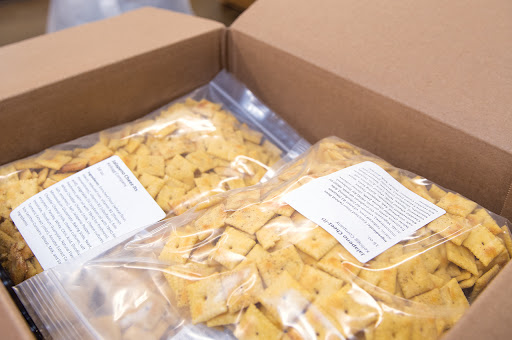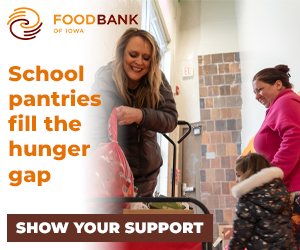Food insecurity continues to increase as need for assistance rises

Food Bank of Iowa volunteers fill individual bags of crackers from a bulk source. Photo by Duane Tinkey
Food insecurity in Central Iowa continues to reach record levels, according to recent reports from the Des Moines Area Religious Council and Food Bank of Iowa.
The reports were issued days before the state announced Monday that SNAP benefits for families with young children would be increasing. On Tuesday the federal government announced that inflation ticked upward slightly, at 0.1% for August, for an annualized rate of 8.3% as food and home prices continued to rise.
The rising levels of food insecurity comes two years after it skyrocketed with the onset of the coronavirus pandemic. The number of people needing assistance to put food on the table has risen again in recent months as inflation surged to its highest levels in 40 years. That was compounded by the reduction in SNAP benefits on April 1.
That need has not subsided.
DMARC recently reported that its food pantry network helped 20,203 people in August, a new record for the month and an 86% increase over August 2021. Of those, nearly 2,000 people used a DMARC food pantry for the first time ever.
At Food Bank of Iowa, more than 136,000 people and nearly 50,500 households were served in the food bank’s 55-county region in July, which is the latest data available from the agency. That was another record, surpassing the previous record of 135,300 people and 48,286 households in June, and the third straight month that a record was set.
Officials with the Food Bank said in a release that the numbers of people seeking food assistance is greater than during the peak of the pandemic and also the highest in the Food Bank’s 40-year history.
Matt Unger, CEO of DMARC, said the level of need in the community is “incredible.”
“People are struggling to meet the new costs for food, housing, child care, health care and transportation,” Unger said. “Wages aren’t keeping up. It’s a balancing act – and families, many for the first time ever, are increasingly turning to food pantries to put food on the table.”
Patty Sneddon-Kisting, executive director of the Urbandale Food Pantry, one of those within the DMARC system, said the pantry is serving more people than ever before.
Andrea Cook, program director at Johnston Partnership Place, another pantry in the DMARC network, said she has seen an increase in the number of new individuals and families seeking assistance.
“They are very grateful, but it is a lot of food that we need to move in each week to keep the shelves stocked,” Cook said. “August is not typically a busy month for us, so we are bracing for what the last quarter of 2022 will bring to our doors.”
Missy Reams, volunteer and community outreach manager at Bidwell Riverside Center, and David Harper, director of Caring Hands Eastview Food Pantry, also said they are seeing a big increase in the number of new people visiting their pantries.
“They are just trying to keep food on the table and feed their children,” Reams said.
Each of those food pantries saw record numbers of visitors in August, DMARC officials said.
Unger called for policy change at the governmental level to help agencies meet the increasing need for assistance.
“Nonprofit organizations are stepping up to meet this record-breaking need, but we can’t and don’t do it alone,” he said. “We’ve had tremendous financial support from our partners – across the board – to help us meet the growing needs. But policy support is important too. We need our government leaders to work with us to make programs like SNAP more accessible and easier to enroll in, not create more barriers to access this critical assistance.”
He said there are not enough charitable dollars available to meet the need and that policies, such as increases in SNAP benefits, can help fill the gaps.
“SNAP is the best tool we have in the fight against hunger,” he said. “With Farm Bill negotiations starting up, it’s important that people not only support their local anti-hunger organizations, but also share the stories and facts we know to be true with elected leaders to help them understand the reality and depth of the situation and the consequences of making it harder to access critical safety-net programs like SNAP.”
On Monday, the Iowa Department of Health and Human Services announced that SNAP benefits for families with children under 6 years old will be increased by $22 per month per child in that age group.
“Food costs in Iowa hit historic highs in 2022, making it hard for low-income parents to meet the nutritional needs of their children,” Janee Harvey, the department’s administrator of adult, child and family services, said in the release. “These additional benefits will make it easier for parents to put healthy and nutritious food on their table.”









